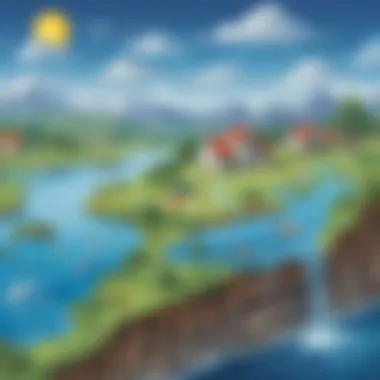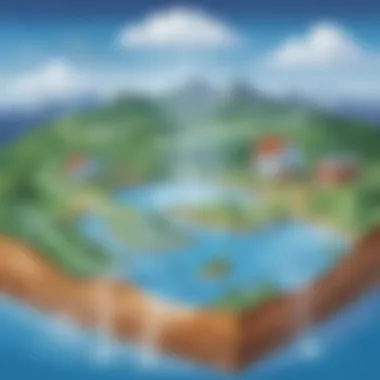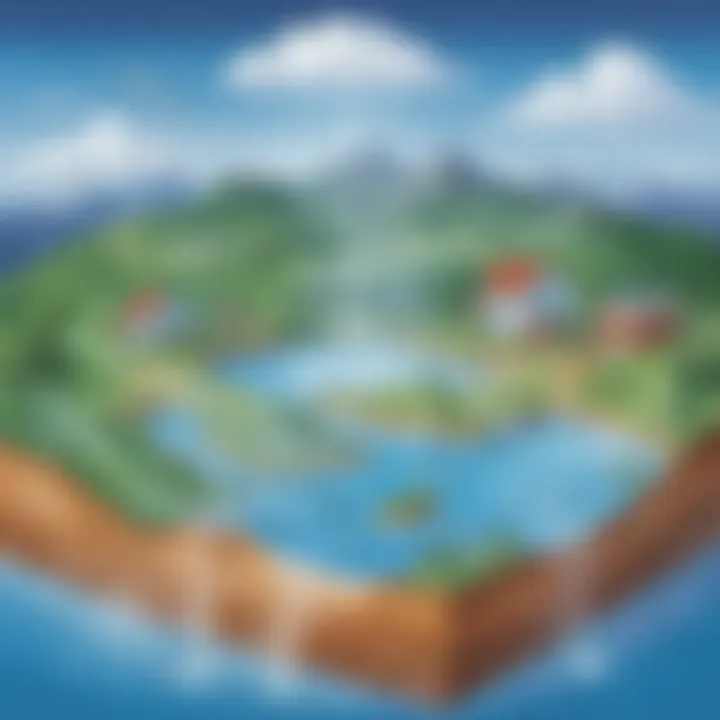Unlocking the Wonders of the Water Cycle: Teaching Techniques for Children Aged 6-12


Science Fun Facts
Water is vital for life on Earth. Did you know that every drop of water you drink today is the same water that existed billions of years ago? Water constantly moves through the water cycle, from the earth to the sky and back again, in a never-ending loop.
Discover the Wonders of Science
To truly understand the water cycle, let's delve into its key components. It all starts with evaporation, where the sun's heat turns water from rivers, lakes, and oceans into water vapor. This vapor then rises into the atmosphere, cools down, and transforms into clouds through a process called condensation.
Science Quiz Time
Are you ready for a fun quiz to test your knowledge about the water cycle? Here's a brain teaser for you: What is the correct order of the water cycle phases? A) Precipitation, Condensation, Evaporation B) Evaporation, Precipitation, Condensation C) Condensation, Evaporation, Precipitation. Test your understanding and see how much you've learned!
Science Experiment Showcase
Now, let's bring the water cycle to life through an exciting experiment! You'll need a water cycle model kit or basic materials like a jar, water, ice, and a heat source. Follow these steps: 1) Fill the jar with water and add a few ice cubes to represent cold temperatures. 2) Seal the jar and place it near a sunny window or under a lamp. 3) Observe the water evaporating, forming condensation on the sides, and eventually dripping back down like rain. Stay curious and explore the wonders of science!
Introduction
Delving into the intricate realm of teaching the water cycle to children aged 6-12 presents a profound opportunity to spark curiosity and foster a deeper understanding of this fundamental natural process. The significance of this educational journey lies in cultivating not just knowledge but a holistic connection to Earth's water systems, weather patterns, and environmental awareness. By unraveling the mysteries of the water cycle through tailored interactive activities and creative resources, young minds can grasp the essence of this vital phenomenon.
Importance of Teaching the Water Cycle
Understanding Earth's Water Systems
Exploring Earth's water systems unveils the intricate web that sustains life on our planet. By delving into the interconnectedness of rivers, oceans, and the atmosphere, children can appreciate the cyclical nature of water and its role in supporting ecosystems worldwide. Understanding Earth's water systems exposes learners to the beauty of Earth's hydrological processes, making complex scientific concepts tangible and relatable even to young audiences.
Impacts on Weather Patterns
The interplay between the water cycle and weather patterns shapes our everyday experiences, from sunny days to torrential rain. By grasping how evaporation, condensation, and precipitation influence local and global weather phenomena, children can contextualize the significance of the water cycle in regulating Earth's climatic conditions. Delving into the impacts of the water cycle on weather patterns empowers young learners to appreciate the delicate balance that sustains life on our planet.
Critical for Environmental Awareness
Nurturing environmental awareness through the lens of the water cycle instills a sense of responsibility in young minds. By connecting the dots between water consumption, pollution, and natural resource management, children can grasp the importance of conserving water and preserving our ecosystems. Emphasizing the critical role of the water cycle in environmental sustainability encourages children to become stewards of the planet, fostering a deeper appreciation for Earth's interconnected systems.


Challenges in Teaching the Water Cycle
Complexity of Scientific Concepts
Navigating the complexities of scientific concepts related to the water cycle poses a unique challenge in educational settings. From understanding the mechanisms of evaporation to tracing the journey of water molecules across various reservoirs, simplifying these intricate processes for young learners requires creativity and clarity. Breaking down the complexity of scientific concepts surrounding the water cycle ensures that children can grasp the fundamental principles underlying this natural phenomenon.
Abstract Nature of the Water Cycle
The abstract nature of the water cycle presents a cognitive hurdle for young learners embarking on a journey of scientific discovery. Visualizing invisible processes like sublimation and transpiration requires innovative teaching approaches that make the intangible tangible. By grounding discussions in real-world examples and hands-on experiments, educators can bridge the gap between abstract concepts and concrete understanding, empowering children to unlock the mysteries of the water cycle.
Engagement for Young Learners
Capturing and sustaining the interest of young learners throughout the exploration of the water cycle demands engaging and interactive learning experiences. Leveraging multimedia resources, interactive experiments, and gamified activities can enhance children's participation and retention of key concepts. Fostering engagement for young learners involves tailoring teaching methods to align with diverse learning styles, ensuring that every child can actively participate in discovering the wonders of the water cycle.
Interactive Learning Activities
In this section on Interactive Learning Activities, we delve into the significant role that hands-on engagement plays in the education of children aged 6-12 about the water cycle. Interactive activities are pivotal as they enable young minds to grasp complex scientific concepts in a tangible and experiential manner. By actively participating in these activities, children can visualize the intricate processes of the water cycle, fostering a deeper understanding and appreciation for the natural world. Furthermore, interactive learning promotes critical thinking skills, encourages curiosity, and enhances retention of information. Through interactive activities, children can actively explore and experiment, solidifying their knowledge in a meaningful and enjoyable way.
Water Cycle Model Demonstration
Materials Needed
When considering the Materials Needed for a Water Cycle Model Demonstration, it is essential to prioritize items that vividly represent each stage of the cycle. Key components may include a plastic container to simulate bodies of water, a heat source for evaporation like a lamp, blue food coloring to represent water, and small models of trees or houses to denote the environment. These materials facilitate a complete and visual representation of the water cycle, making it easier for children to comprehend the processes involved. Their multi-sensory nature allows for a more engaging and memorable learning experience, enhancing retention and understanding.
Step-by-Step Instructions
The Step-by-Step Instructions for a Water Cycle Model Demonstration are fundamental in guiding young learners through the stages of evaporation, condensation, and precipitation. By breaking down these processes into clear and manageable steps, children can follow along and actively participate in each stage of the experiment. The instructions should be simple, concise, and easy to understand, ensuring that children can replicate the model demonstration independently to reinforce their learning. This hands-on approach promotes a deeper understanding of the water cycle and instills a sense of accomplishment in children as they witness the cycle in action.
Discussion Points
Discussion Points are essential in facilitating meaningful conversations and reflections on the Water Cycle Model Demonstration. By posing thought-provoking questions such as 'What happens when water evaporates?' or 'How does precipitation affect the environment?', educators can prompt critical thinking and enhance comprehension. These discussions allow children to express their observations, ask clarifying questions, and connect the model demonstration to real-world scenarios. By encouraging dialogue and exploration, educators can deepen children's understanding of the water cycle and inspire a curiosity for scientific inquiry.
Creative Resources


Creative resources play a crucial role in enhancing the learning experience of children aged 6-12 about the water cycle. These resources, ranging from songs and rhymes to storybooks and arts and crafts, offer interactive and engaging ways to simplify complex scientific concepts for young minds. By incorporating creative elements, educators can make the topic more accessible and enjoyable, fostering a deeper understanding and appreciation for the natural processes that govern our world.
Water Cycle Songs and Rhymes
Catchy Melodies
Catchy melodies form the backbone of engaging educational tools for teaching the water cycle to children. The repetitive nature of catchy tunes enhances memorization and retention, making learning fun and effective. In this article, catchy melodies serve to simplify intricate scientific details, aiding in the comprehension of water cycle stages effortlessly. One key advantage of using catchy melodies is their ability to capture and maintain young learners' attention, ensuring active participation and knowledge absorption throughout the teaching process.
Lyrics Explaining the Process
The use of lyrics to explain the water cycle process is instrumental in breaking down complex scientific jargon into digestible pieces for children. By incorporating clear and concise lyrics that elucidate each stage of the water cycle, educators create a bridge between abstract concepts and tangible experiences. This approach not only facilitates understanding but also sparks curiosity and inquiry, encouraging children to explore further and ask questions, thereby deepening their engagement and knowledge retention.
Sing-Along Opportunities
Sing-along opportunities act as a powerful reinforcement tool in the learning process of the water cycle. By inviting children to actively participate in singing and reciting the lyrics of water cycle songs, educators promote active learning and interactive engagement. Sing-along sessions create a lively and dynamic atmosphere, where children can internalize information effortlessly while enjoying the educational experience. The collaborative aspect of sing-along activities fosters a sense of community and shared learning amongst participants, further enhancing the overall effectiveness of teaching the water cycle through musical elements.
Water Cycle Storybooks
Illustrated Stories
Illustrated stories hold the potential to captivate young readers' imaginations while conveying essential knowledge about the water cycle. Through captivating visuals and narrative storytelling, illustrated storybooks offer a multidimensional approach to explaining scientific phenomena in a relatable and engaging manner. In this article, illustrated stories serve as visual aids that complement textual information, providing children with a holistic understanding of the water cycle through a blend of imagery and narrative.
Narratives Simplifying the Concept
Narratives simplifying the concept of the water cycle help bridge the gap between abstract theory and real-world applications for young learners. By presenting the water cycle as a narrative journey with relatable characters and scenarios, educators create a pathway for children to connect with the natural process on a personal level. Simplified narratives not only facilitate comprehension but also make the topic more accessible and meaningful to children, inspiring their curiosity and facilitating a deeper connection with the intricate workings of the water cycle.
Discussion Questions
Incorporating discussion questions in water cycle storybooks cultivates critical thinking skills and encourages active participation in the learning process. By prompting children to reflect on the story's themes, characters, and scientific concepts, discussion questions stimulate intellectual curiosity and foster deeper engagement with the material. This interactive approach promotes dialogue and exchange of ideas, empowering children to express their thoughts and interpretations of the water cycle's dynamics, thus enhancing their cognitive development and analytical skills.
Water Cycle Arts and Crafts
DIY Projects Demonstrating the Cycle


DIY projects that demonstrate the water cycle offer a hands-on approach to learning, allowing children to explore and experiment with the natural process in a practical and tangible manner. By engaging in DIY construction of water cycle models or demonstrations, children actively participate in the conceptualization and visualization of complex scientific concepts. This experiential learning fosters creativity and critical thinking, as children collaborate and problem-solve to create representations of the water cycle, reinforcing their comprehension and retention of essential knowledge.
Hands-On Crafting
Hands-on crafting activities provide children with the opportunity to engage their tactile and creative skills in understanding the water cycle. Through crafting various elements of the water cycle, such as clouds, precipitation, and evaporation, children not only enhance their artistic abilities but also internalize the sequence and significance of each stage. Hands-on crafting promotes kinesthetic learning, allowing children to physically manipulate materials and shapes, reinforcing their understanding of scientific processes through sensory exploration and experimentation.
Display and Explanation
Displaying and explaining water cycle arts and crafts creations helps solidify children's learning by encouraging them to showcase and articulate their understanding of the natural process. By presenting their crafted representations of the water cycle to peers or adults, children practice verbalizing scientific concepts, enhancing their communication skills and self-expression. Additionally, through peer feedback and discussions, children reinforce their comprehension of the water cycle while celebrating their creative achievements, fostering a positive and inclusive learning environment that values both individual expression and collective learning.
Practical Applications
Understanding and experiencing the concepts of the water cycle directly in nature can significantly enhance children's comprehension and appreciation for this vital natural process. By immersing themselves in practical applications, children aged 6-12 can grasp the complexities of the water cycle firsthand, fostering a genuine connection with the environment. Furthermore, practical applications inspire curiosity and critical thinking, encouraging young learners to explore the world around them with a scientific lens. Through field trip ideas, outdoor exploration, and documentation and reflection, children can witness the water cycle in action, solidifying their knowledge and understanding.
Water Cycle Observation in Nature
Exploring the water cycle through field trips provides a dynamic and interactive learning experience for children. Field trip ideas encompass visits to local water bodies, such as ponds, rivers, or water treatment plants, allowing students to observe evaporation, condensation, and precipitation processes in real-time. This hands-on approach enables children to connect theoretical knowledge with practical observations, enhancing their understanding of the water cycle's significance. Field trips also promote environmental awareness and a sense of stewardship, encouraging children to value and preserve Earth's natural resources.
Outdoor Exploration
Engaging in outdoor exploration serves as a key element in reinforcing children's understanding of the water cycle. Encouraging youngsters to explore natural surroundings, such as parks, gardens, or forests, offers opportunities to witness water cycle phenomena, such as transpiration and runoff. By interacting with nature firsthand, children can perceive the interconnectedness of water cycle components and recognize their role in maintaining ecological balance. Outdoor exploration fosters a sense of wonder and discovery, sparking youngsters' curiosity and nurturing a lifelong appreciation for the environment.
Documentation and Reflection
Encouraging children to document their observations and reflect on their experiences in nature enhances their learning journey. Through journals, sketches, or photographs, students can record water cycle observations, weather patterns, and environmental changes over time. This documentation not only reinforces scientific concepts but also promotes critical thinking and communication skills. Reflection activities allow children to synthesize their learning, make connections between theory and practice, and develop a deeper appreciation for the complexities of the water cycle.
Water Conservation Practices
Integrating water conservation practices into children's education empowers them to become responsible stewards of Earth's precious resources. By incorporating water-saving tips, hands-on conservation activities, and community engagement initiatives, educators can instill sustainable habits and values in young learners, fostering a sense of environmental responsibility and activism.
Water-Saving Tips
Educating children on simple yet effective water-saving tips, such as taking shorter showers, fixing leaky faucets, and turning off the tap while brushing teeth, reinforces the importance of water conservation practices in daily life. By consciously practicing water-saving habits, children can contribute to water preservation efforts at home and school, instilling a sense of accountability for water usage and sustainability.
Hands-On Conservation Activities
Engaging children in hands-on conservation activities, such as setting up rain barrels, creating drought-resistant gardens, or participating in water clean-up projects, cultivates a direct connection to environmental preservation. These practical experiences not only educate children on the impact of their actions on water resources but also foster a sense of empowerment and agency in safeguarding the environment. Hands-on activities motivate children to become proactive environmental advocates, driving positive change in their communities.
Community Engagement Initiatives
Involving children in community engagement initiatives related to water conservation promotes social awareness and collective action. Collaborating on water-saving campaigns, participating in river clean-ups, or advocating for sustainable water policies empowers children to make a tangible difference in their local and global environments. By instilling a sense of civic responsibility and environmental stewardship, community engagement initiatives inspire children to become change agents and leaders in promoting water sustainability for future generations.







